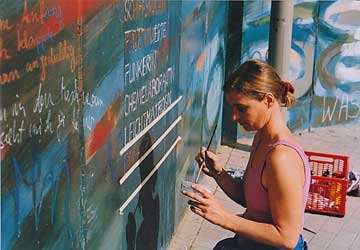The Elbe and the 'work' waves, 2003 / 2010

The draft

The mural
"The Elbe and the 'work' waves"
Neumühlen 16-20, Road bend near Lawaetzhaus.
Designed and painted: Anja Grosse.
Photos: Hildegund Schuster ©
Abandoned in 2010 after unsuccessful restoration.
Mural purloined, mural discontinued: even that happens in the Women's Open Air Gallery Hamburg.
Here we're talking about a painting created in 2003 by the Hamburg artist Anja Grosse on the 50 metres long concrete wall made available by Altona District at the sharp bend in the road in Neumühlen, as the eleventh picture in our open air gallery.
The view from above of an expanse of water shimmering in many different blue and ochre tones was the inspiration for this artistic impression of a flowing river: with billowing waves, whirls, splashes and swirls: a variegated glimmering mixture, glistening with manifold bright reflections of light.
This moving waterway grabbed attention with its vibrating colours and inscriptions. At a closer look, it was possible to make out words and phrases designed in different styles, colours and sizes.
The basic idea: to give expression to the work done in the second shift - in the home and the family, bringing up children, caring for family members, juggling all the joys and all the burdens.
How does this link in with work in the port? Our interviews with the women working in the port gave clear answers: it's hard to separate gainful employment and the caring work done in the family. given the workload waiting for female fish workers, welders, prostitutes, coffee bean sorters or engineers when they get home.

Anja Grosse painting the mural
Photo: Hildegund Schuster ©
Hitherto, the second shift had only been featured visually in the Women's Open Air Gallery in the word strips accompanying the murals. And so the idea was born to write quotations from the interviews with the port women actually in the waves. The title "The Elbe and the 'work' waves" is taken with a touch of irony from a work of literature: 'The sea and the "love" waves' by Franz Grillparzer.(1)
Here are some examples of words found in the waves:
"Latchkey kids". "Fish clothes in the laundry every week". "Either your bloke or your kid". "Sometimes the men were pretty weak: they're not all strong guys". "My husband was unemployed. All he did was drink". "It wouldn't have been like that if I hadn't had small kids".
Following the severe winter of 2010, the mural needed to be restored. But the artist wanted to go beyond restoration and change the mural completely. This led to differences with the management of the Women's Open Air Gallery. Unfortunately, it was not possible to reach an agreement so that this mural was discontinued.
© Elisabeth von Dücker, 2011
(1) Tragedy in five acts, 1840

